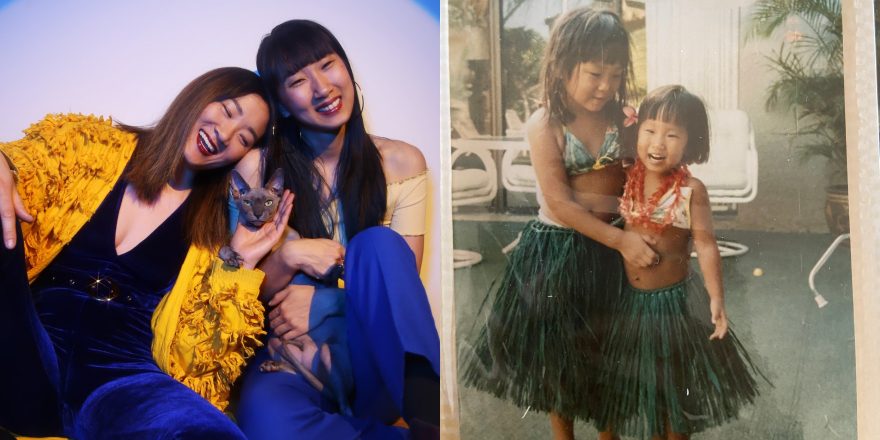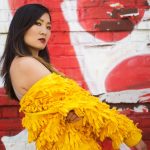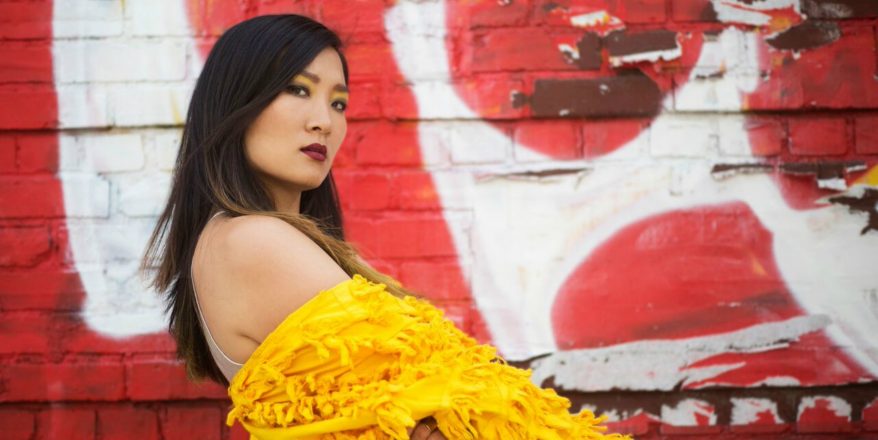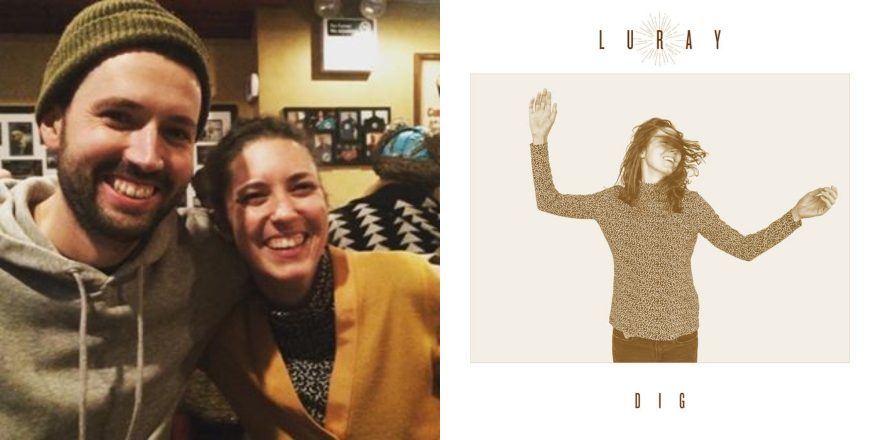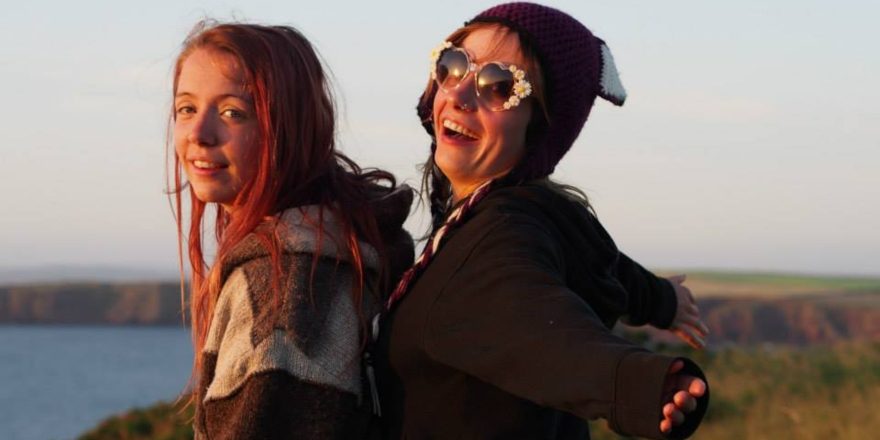True story: my sister Liann picked up guitar before I did. She had a white Fender Squier on which she taught herself Jimi Hendrix’s “Wind Cries Mary” to my awe and envy, listening through the wall in my adjacent bedroom. Keep in mind, this was the early 2000s, pre-YouTube — so we had to resort to dodgy tab websites which regularly gave our computers viruses. While I was obsessed with Britney Spears and S Club 7, she was rocking Zeppelin and Nirvana. She somehow persuaded our mom to buy her a drum kit and learned to play “Smells Like Teen Spirit.” At the age of 11 to my 13, she was my first mentor of rock & roll.
Our weekends consisted of a one-two punch at the Scottsdale, Arizona strip mall: We hit up Guitar Center and spent approximately five hours in the acoustic section playing Dave Matthews Band songs. Then we hit up Best Buy next door and bought a new record to play on the way home — Alanis, Red Hot Chili Peppers or something to that effect.
As I began writing songs and got more into music, she got more into film. I remember coming home one day to see her in the backyard with our mom’s VHS video camera in hand, gesturing wildly as she directed her friends in a flawless shot-for-shot parody of the All That opening sequence, trampoline and all. It was impressive for a 14-year-old, and she became a mini celebrity at our high school because of it.
Our first musician/filmmaker collaboration happened in college, when she was 17 and I was 19. It was the ultimate DIY aesthetic, with me making and cutting dozens of paper props and her calling in all the film nerd friends she had to create my first music video. 13 years later, she’s now a professional filmmaker, I am a professional musician, and we’ve made over 10 music videos together. She’s heard every version of every song I’ve ever written, and she’s the first person I go to with an idea for a video, knowing she’s the only person capable of bringing the visual in my head to life.
When Talkhouse invited her to interview me, we jumped at the chance to talk about growing up Asian American, defending our decisions to be artists in spite of our parents’ wishes, and our ardent love of K-Pop.
— Charlene Kaye
Liann Kaye: I’m very excited to be interviewing you à la Beyoncé and Solange, and although I wouldn’t dare compare ourselves to our lords and saviors, it was the first interview that came to both of our minds when Talkhouse asked us to write something.
Charlene Kaye: It’s true! Bless Mama Tina’s gifted womb. It’s inspiring to have them as creative sister role models.
Liann: Do you think our parents weep every night that God gave them two artists for daughters?
Charlene: They certainly weep that I don’t have a 9-to-5 with benefits or a 401k — but you actually have a résumé that they understand!
Liann: As two Chinese-American kids, our culture and family has taught us that art is frivolous and selfish. How did you find the courage to pursue music right out of college, in the face of that?
Charlene: As I’m sure you’re experiencing right now, so much about Asian child rearing is about shame, and using shame to discipline and set your kids on the “right” path. I felt so much shame going out into the world pursuing music after college — our parents outright disapproved of it and I knew that in doing what I loved, I would be disappointing them. I’m still disappointing them! [Laughs.] Mom and I went to therapy together the last time I was home, and I told her I’d never really felt seen by her because she disapproved of the thing that comprises the fabric of my identity — my musician self, my artist self. It was heavy. I think our lesson in this life is learning to accept each other, even though we can’t understand each other a lot of the time.
Liann: Yeah, even though Mom moved to America so she — and we — could have the “American Dream.” I feel like she is naturally more American than a lot of our family in Singapore.
Charlene: Totally. The American Dream is based so much more on succeeding as an individual than serving society at large. For me, that’s music. But to our mom, what she thinks of when she thinks of “going on tour,” is like, Whitesnake in the ‘80s destroying hotel rooms and doing blow with naked girls and stuff. She still thinks I’m a total miscreant — when the truth is, I don’t even really drink!
Liann: It’s true. Mom couldn’t have raised two kids that got in less trouble, and yet she’s still somehow terrified we’re going to O.D. in an alley someday.
Charlene: I feel like when I joined Guns N’ Hoses [KAYE’s all-girl Guns N’ Roses cover band in which she plays Slash], her worst fears were all confirmed. When she first saw a promo pic of us, she lost it and was like, “WHAT ARE YOU DOING HANGING OUT WITH ALL THESE PROMISCUOUS GIRLS SMOKING CIGARETTES?! YOU HAVE LOST YOUR WAY!” I was like, “Relax mom, it’s like…a costume party! It’s like Halloween!” She also still thinks the name of that band is “Guns and Hoes.” Which I can’t bring myself to correct her over because… it’s just too funny.
Liann: I’ve really loved making your music videos, but I have always looked at it as a way to stand behind the artist and support them. Quitting my video editing day job and writing my screenplay this year was the first time I’ve ever made something that was completely mine. I kind of freaked out about how raw and vulnerable that made me feel, and I had to go to you for advice about how you stay sane when you’re releasing albums.
Charlene: Welcome to the club! It’s true that being raw and vulnerable with your work is one of the scariest experiences an artist can have, but what is that Martin Scorsese quote? “The most personal is the most creative”? That’s something that took me a minute to learn, but it’s the only way I can make art now. Everything I write is based on personal experience; trying to understand myself and my experiences through writing about it.
Liann: I think it’s so courageous. I honestly never truly knew what it felt like before this year.
Charlene: Thanks! I’m so proud of you too for following your dreams and telling the stories you want to tell. I remember when I first told our mom that I wouldn’t be going to graduate school after college like she wanted me to, and that I was going to move to New York to wait tables and be a musician. It felt like World War III…I just remember crafting these long, angsty, impassioned emails defending my decision to be an artist, even if it made me no money. I would probably be much more eloquent about it today, but at the time, I think having to write that thesis was the first step of digging my heels into the ground and putting my devotion to music in black and white. Not just to prove it to them that I could do it, but to prove it to myself.
Liann: Something I also asked you about was how you found the courage to invest in a project, your money, your time, your heart and soul, and what if nothing “happens” ?
Charlene: It’s so hard to ignore the outcome when you make anything — we are human beings and we have egos. Egos are important too — they give us our sense of personhood, our identity, our self-worth. But when your ego alone runs the show, the work suffers. Because all the ego wants is reward, reward, and more reward, and when that well runs dry, what do you have left? In the past, I would have cried if I didn’t get such-and-such accolade — maybe it was like a blog writeup or a playlist or whatever. But maybe it’s being in my 30s, maybe it’s just having seen more and experienced more — I just don’t care anymore. I only care about turning myself on with what I make, and having no attachment to the outcome has made my mental health in the creative process so much better.
Liann: Who are you speaking to in the song “Too Much”?
Charlene: I feel like “Closer Than This” and “Too Much” are sister songs in the sense that they reflect two opposing aspects of romance. “Closer Than This” is about desire via mystery and idealization — inventing the version of yourself and the other person that’s the most convenient, the most palatable. “I don’t need to see your edges or your complicated bits.” It’s about a relationship that maintains its novelty via keeping someone at arm’s length emotionally. With “Too Much”, it’s about that next step — actually seeing all those edges and complicated bits. You pull the veil back after the initial high and realize, wait — here is a real person, who has imperfections, who has all this baggage, who is deeply wounded and messy in her own way. Are you still down for that? Spoiler alert: most aren’t. “Too Much” is about declaring, OK, not only am I not remotely perfect; I’m not for everyone. But it turns out that men I always thought I was too much for, just weren’t enough for me.They were down for the fantasy, but they weren’t down for someone who was complex and angry and effusive and ambitious and relentless.
Liann: What Asian artists are you obsessed with right now?
Charlene: I’m so psyched to see more Asian Americans in indie rock — Rina Sawayama is incredible, so is Beabadoobee, Japanese Breakfast, Mitski. Then of course, so psyched to see Bowen Yang as the first Asian American cast member of SNL, and to see Parasite winning [Best Picture]! It feels like these little breakthroughs are adding up to something, and I’m here to continue that trend. How about you?
Liann: Seeing Ali Wong’s Netflix special was the first time I think I understood why people liked stand up. I never really enjoyed the format of white dudes telling self-deprecating stories to me, but when she did it I felt like she was speaking right to me! I also loved The Farewell with Awkwafina and Lulu Wang, seeing Constance Wu as a badass leading lady in Hustlers was so exciting — you never see a powerful, sexy Asian woman on screen! To All the Boys I’ve Loved Before — I am Lara Jean. Lara Jean is me. And then we can’t forget BTS, NCT127, and PSY.
Charlene: Yes, heart eyes emoji forever for Lay Zhang. Dreamboat. I also loved The Farewell, and we both love To All The Boys I’ve Loved Before. If anyone stops by our house, it’s more than likely we’re binging K-pop videos.
(Photo Credit: left, Felipe Torres)


